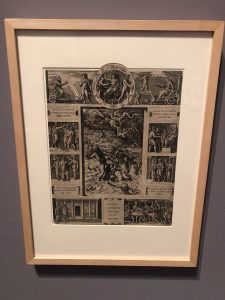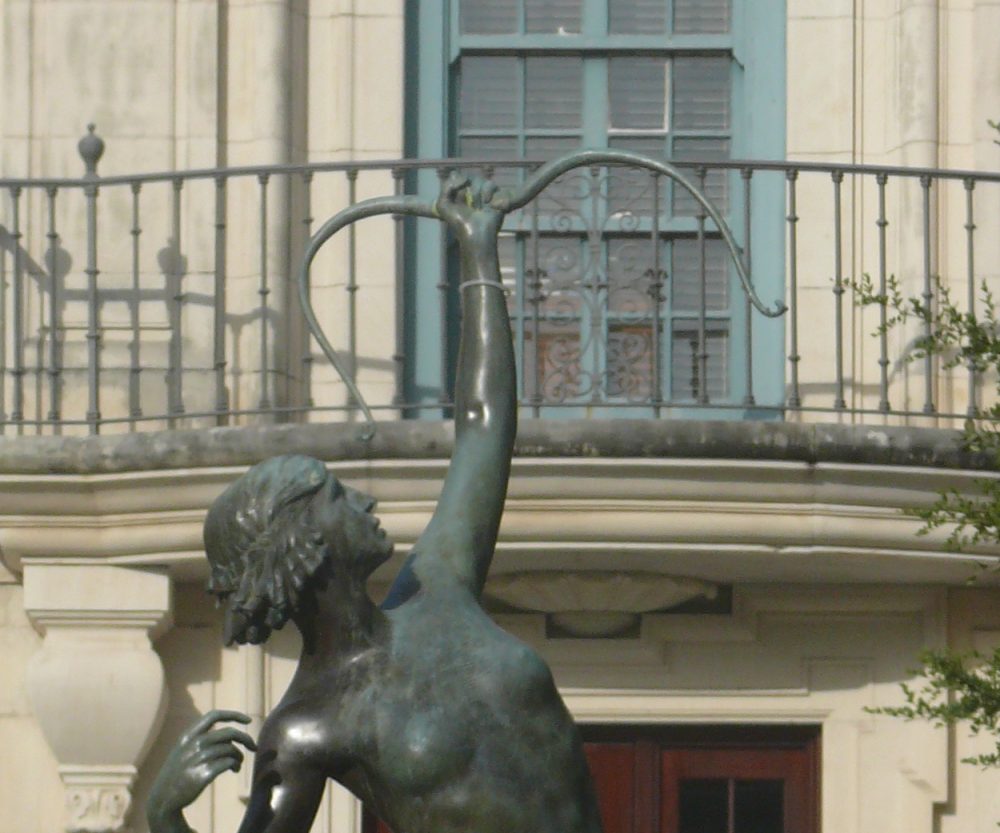 I. Artist: The author of Quos Ego was Marcantonio Raimondi. Marcantonio was an engraver who was born close to Bologna, Italy in 1480 (Britannica 2019). He was highly skilled in his area of work, and this could possibly be credited to the person who trained him, Francia, who was a successful goldsmith as well as an extraordinary painter (Britannica 2019). Most of Raimondi’s best work was created when he started copying the works of Michaelangelo and Raphael (Britannica 2019). He was even fortunate enough to meet Raphael himself, who seemed to like Raimondi enough to insert him into his Explusion of Heliodorus (1513) (Britannica 2019). Raimondi’s connection to Raphael was his most important aspect when it came to his artwork. Some of Raimondi’s printings were Dream of Raphael (1507), The Climbers (1510), Massacre of the Innocents (1512-1513), and The Judgement of Paris (1510 – 1520). While many of Marcantonio Raimondi’s engravings were recreations, there was no doubt that the man was a wonderful artist.
I. Artist: The author of Quos Ego was Marcantonio Raimondi. Marcantonio was an engraver who was born close to Bologna, Italy in 1480 (Britannica 2019). He was highly skilled in his area of work, and this could possibly be credited to the person who trained him, Francia, who was a successful goldsmith as well as an extraordinary painter (Britannica 2019). Most of Raimondi’s best work was created when he started copying the works of Michaelangelo and Raphael (Britannica 2019). He was even fortunate enough to meet Raphael himself, who seemed to like Raimondi enough to insert him into his Explusion of Heliodorus (1513) (Britannica 2019). Raimondi’s connection to Raphael was his most important aspect when it came to his artwork. Some of Raimondi’s printings were Dream of Raphael (1507), The Climbers (1510), Massacre of the Innocents (1512-1513), and The Judgement of Paris (1510 – 1520). While many of Marcantonio Raimondi’s engravings were recreations, there was no doubt that the man was a wonderful artist.
II. Date: Raimondi created Quos Ego from approximately 1515 to 1516 (Kleinbub 2012). Because artwork can take time to be made, there needed to be a year or so between the start and the finish.
III. Location: Quos Ego is just one of the many mythological artworks located in the Blanton Museum.
IV. Reason for Acquisition: Raimondi’s printing was introduced to the Blanton Museum in 1985. While I was able to find a date to when the item was added to the Museum, I could not find an exact reason to why the University of Texas decided to add this item to campus. However, I did find some ideas. According to austintexas.org, “the Blanton offers thought provoking, visually arresting, and personally moving encounters with art (Blanton).” Looking at Quos Ego, any viewer would feel all of these emotions. Thus, this explains why the UT may have decided to include this artwork on campus. Also, because Raimondi as well as Raphael were both involved with saving the Roman artwork, maybe UT thought that would be a great idea to keep that tradition going. However, all of this is only pure speculation, and none of this is exact conclusive evidence stating why Quos Ego is on campus.
V. Description: Quos Ego is a print on paper. Raimondi engraved all of the nine images. The height of artwork is 42.2 cm, and the width is 32.6 cm (Object). Also, there are five sentences inscribed on the engraving that read AEOLVS IMMITTIT VENTOS IVN ONE PRECANTE, TROLANQSO VAGOS LIBYCAS EXPELLIT IM ORAS, CVI VENVS ASCANII SVB IMAGINE MITTIT AMOREM, SOLATVRVENEREM DICTIS PATER IPSE DOLENTEM, and AENEAM RECIPIT PVI CHRA CARTHAGINE DIDO.
Marcantonio Raimondi’s engraving the Quos Ego contains ten images all coming from book 1 of Virgil’s Each image describes a certain event that occurred during the epic poem. The first, and most central image, describes Neptune calming the storm so Aeneas can get past safely (Virgil 1983, p. 8, lines 133-152; Kleinbub 2012). Aeolus, the controller of the winds, was commanded by Juno to go after Aeneas because he is the son of Venus (Virgil 1983, p. 5-6, lines 65-76; Kleinbub 2012). The image in the top left corner describes the moment Juno tells Aeolus what he must do. The top round image, right above the central image, shows Venus begging Jupiter to save Aeneas (Virgil 1983, p.11 -12, lines 235-248; Kleinbub 2012). Jupiter responds by sending Hermes to help out and letting Venus know that Aeneas’ sons will rule in the future (Virgil 1983, p.12, lines 260 – 264). The upper right picture describes the moment when Venus sends Cupid to support Aeneas (Virgil 1983, p.28, lines 685 – 690; Kleinbub 2012). As we have seen, the mythological character Venus, plays a huge role in Virgil’s Aeneid. The two images to the right of the central Neptune print we see the Trojans in the throne room of Dido (upper image), and Dido escorting Aeneas and his men to the banquet (Virgil 1983, p.26 and p.28, lines 635 and lines 696-697; Kleinbub 2012). The bottom right image describes the feast of Dido, Aeneas, and Ascanius who is actually disguised as Cupid (Virgil 1983, p. 28-30, lines 699-756; Kleinbub 2012). The two left images explore the moment right after the storm when Aeneas is talking to all of the men who have survived (Upper Image), and Aeneas talking to his mother (Virgil 1983, p.10 and p.14, lines 202-217 and lines 313-316; Kleinbub 2012). The bottom left and last image looks at the moment when Aeneas and Achates explore the temple of Juno (Virgil 1983, p.28, lines 699-700; Kleinbub 2012). During this moment, they are looking at all of the paintings. Obviously, there is a lot of meaning that goes into the Quos Ego. The significance as well as the symbolic meaning of Raimondi’s engraving was to describe events that took place in the book 1 of the Aeneid by Virgil. Christian Kleinkub, a specialist in Italian Renaissance art, suggests that the Quos Ego “elevated verses of Virgil’s poetry to their ennobled equivalents in black line” and “recovered terms of Roman art (Kleinbub 2012, p.287, lines 8-10).” This piece of artwork allows viewers to understand the importance of Roman art and how influential it was on art in general. Although saying piece of artwork is a little bit of understatement because the Quos Ego seems to be more of a collection rather than one single piece of art due to the numerous images. As a viewer, there is numerous amounts of mythological elements that can be observed from the images. Neptune, Jupiter, Juno, Venus, Cupid, and Mercury were all mentioned in the some of these images. From Greek and Roman mythology, all of these are important gods and goddess that play huge roles throughout many other myths. Also, there is Aeneas who is connected all the way back to the line of Hector. Then, lastly, Dido who is the queen of Carthage, and is a very important female figure in Greek and Roman mythology. Also, one thing yet to be mentioned is the twelve zodiac signs that surround the round image of Jupiter, Mercury, and Venus. This is extremely unique because as the Earth would revolve around the stars each year, there were constellations that would show up and each were named after a god or goddess (Myths, lines 1-11) . So, the meaning of the zodiac signs is really important because they add even more mythological elements to Raimondi’s engraving. Lastly, while I was never able to find the true translations of the five inscriptions, my TA, William Farris, managed to assist me in the translations of the Latin sayings. As mention before, the top left inscription reads, AEOLVS IMMITTIT VENTOS IVN ONE PRECANTE. This implies that Aeolus is sending the winds while Juno demands it (Farris 2019). The top right sentence reads, SOLATVRVENEREM DICTIS PATER IPSE DOLENTEM. This means that Jupiter is caring for Venus as she is grieving through her words (Farris 2019). The bottom left reads, TROLANQSO VAGOS LIBYCAS EXPELLIT IM ORAS, and this is connected to the last one because it explains that Jupiter is expelling the soldiers onto the Libyan shores (Farris 2019). The reason these are connected is since Venus is so worried about her son Jupiter knows he must save them somehow. The bottom right inscription interprets, AENEAM RECIPIT PVI CHRA CARTHAGINE. This translates to, “Beautiful Dido receives Aeneas in Carthage (Farris 2019).” Lastly, the very bottom explains, CVI VENVS ASCANII SVB IMAGINE MITTIT AMOREM, and this is describing the moment Venus sends Cupid disguised as Aeneas’ son (Farris 2019). Overall, all of these inscriptions connect to some of the paintings by captioning them. In turn, the whole artwork explains the events that occurred in book 1 of Virgil’s Aeneid.
Bibliography
Britannica, The Editors of Encyclopaedia. 2019. “Marcantonio Raimondi.” Encyclopoedia Britannica, Encyclopaedia Britannica. https://www.britannica.com/biography/Marcantonio-Raimondi
Christian K. Kleinbub. 2012. Raphael’s Quos Ego: forgotten document of the Renaissance paragone, Word & Image,28:3, 287-301, DOI: 10.1080/02666286.2012.724571
“Blanton Museum of Art.” Visit Austin, TX, www.austintexas.org/listings/blanton-museum-of-art/1580/.
“Object Results.” Blanton Museum of Art Online Collections Database, collection.blantonmuseum.org/Obj15?sid=108193&x=2062200.
“Myths of the Greek Zodiac.” Myths of the Greek Zodiac, https://www.igreekmythology.com/greek-zodiac.html
Virgil. The Aeneid. Translated by Robert Fitzgerald. 1983. United States, New York: Random House
Farris, William. 2019. Literal Translation. Quos Ego [Neptune Calming the Tempest], after Raphael. By Marcantionio Raimondi
Written By: Jason “Ky” Hoover
